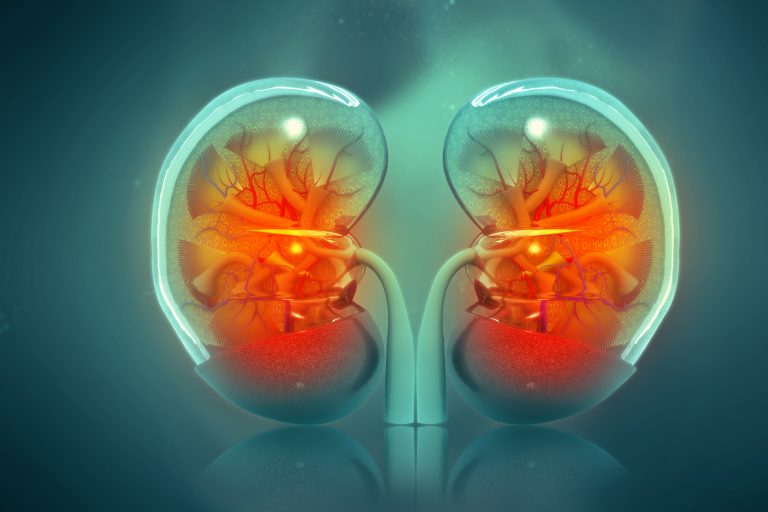
A drug regimen that combines VEGFR inhibitor drugs with a peptide, angiotensin-(1,7), which is generated by the ACE2 enzyme, can overcome treatment resistance and improve survival in mice with the common kidney cancer renal cell carcinoma (RCC), according to a team of researchers from the U.S. and Ireland.
The team’s analysis of human RCC ACE2 expression data suggested that ACE2 expression is a good prognostic factor in RCC, and additional studies also indicated that loss of ACE2 mediates resistance to classical treatments. Their experiments in preclinical models of RCC showed that triple therapy using established treatments plus angiotensin-(1–7) can improve tumor response and significantly prolong survival. The discoveries suggest that bolstering ACE2 could improve how patients respond to VEGFR inhibitors, which often lose their effectiveness against cancers over the long term.
“Our team reported that ACE2 is a new protective molecule for RCC, and building on this finding, we show that angiotensin-(1–7), a small peptide generated by ACE2, can be used to control tumor growth in preclinical models,” said Rupal Bhatt, MD, PhD, a medical oncologist at Beth Israel Deaconess Medical Center (BIDMC), and associate professor of medicine at Harvard Medical School, who is co-corresponding author of the team’s paper in Science Translational Medicine. “Our findings suggest that angiotensin-(1–7) could be developed in clinical trials as a promising therapeutic option in patients with RCC in combination with current standard of care treatments and has a strong potential to improve overall survival.”
Bhatt, together with Thomas Walther, PhD, a professor in pharmacology at University College Cork, Ireland, and colleagues, report on their findings in a paper titled, “ACE2 abrogates tumor resistance to VEGFR inhibitors suggesting angiotensin-(1–7) as a therapy for clear cell renal cell carcinoma.”
Renal cell carcinoma is one of the 10 most common cancers in men and women, and clear cell RCC (ccRCC) constitutes about 80% of RCC cases, the authors wrote. In 2018, there were an estimated 403,000 new cases of RCC and 175,000 deaths due to kidney cancer worldwide. Currently, the 5-year survival rate for patients with metastatic RCC is only about 12%.
Current treatments for RCC include inhibitors of vascular endothelial growth factor (VEGF) and immune checkpoint inhibitors (ICI) of the programmed death-ligand 1 PD-L1 pathways. However, the authors pointed out, resistance to treatment occurs in most patients, which means that new combination treatments are still needed to enhance the efficacy of these current approaches. “…resistance to single-agent VEGF receptor–tyrosine kinase inhibitor (VEGFR-TKI) universally develops at a median of 1 year,” they stated. “In addition, although responses are seen in most patients who receive VEGFR-TKI in combination with ICI, only a small subset of patients has long-term durable responses.”
ACE2 is an enzyme that belongs to the renin-angiotensin system (RAS) and antagonizes the classical angiotensin II/AT1 receptor pathway. Interestingly, it is also the receptor for the SARS-CoV2 spike protein, and its downregulation by the virus leads to the often-deadly progression of acute respiratory distress syndrome in COVID-19 patients.
Research reported by Bhatt, Walther and colleagues has now shown that higher ACE2 expression correlates with better overall survival in patients with RCC. The team investigated the role of ACE2 in kidney cancer using transcriptomic data from 533 ccRCC tumors. They discovered that patients with higher expression of the ACE2 gene showed longer survival times, including overall survival (OS), disease-specific survival, and progression-free interval. Additional studies demonstrated that overexpressing the enzyme in a mouse model of ccRCC slowed tumor formation. “… we show that higher ACE2 expression in primary ccRCC tumors correlates with better patient survival outcomes and that ACE2 has a direct antitumor effect on ccRCC in both in vitro and in vivo models,” they wrote.
Through their experiments the team in addition demonstrated that VEGF receptor inhibitors such as sunitinib and axitinib act to downregulate ACE2 expression both in tumor cells in culture, and in tumors in mouse models of RCC. Using novel methods and techniques, the team generated multiple lines of evidence indicating that ACE2 downregulation can be causative for the resistance to VEGF pathway inhibition, the inevitable consequence of this approved used class of drugs.
Further studies suggested that the peptide angiotensin-(1–7), which is generated by ACE2 activity, is the likely mediator of this effect, and that combining VEGF pathway inhibitors with anti-PD-L1 and angiotensin-(1–7) as triple therapy is more effective than the current standard treatment that combines VEGR and PD-1 pathway inhibition. “We show that Ang-(1-7) is an important downstream mediator of such ACE2 effects and has antitumor activity in preclinical models, especially in combination with VEGFR-TKIs and ICI, opening an avenue of additional therapeutic strategies in ccRCC,” they wrote. “… these results suggest that targeting the ACE2/Ang-(1–7) axis is a promising therapeutic strategy against ccRCC.”
“Our work shows that angiotensin-(1–7) could provide a promising therapeutic option in patients with RCC in combination with VEGF-pathway inhibitors,” said co-corresponding author Walther. “Resistance to VEGF-pathway inhibitors is a general problem in cancer treatment and therefore our findings have broader implications for VEGF-pathway inhibitor therapies that beyond RCC could be extended to other types of cancers.”













